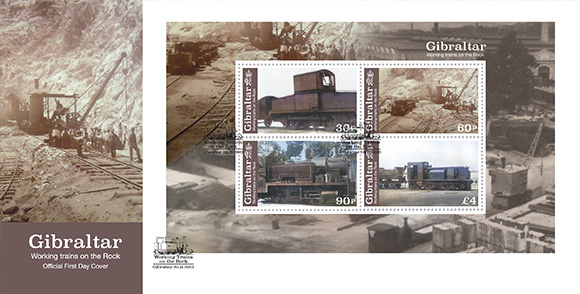Home -> Stamps -> 2023 -> Working Trains on the Rock -> FDC Miniature Sheet
We also recommend:

Working trains on the Rock (view technical specs)
The historical significance of the railway system in Gibraltar’s Dockyard area is notable, as it once intricately connected vital components of the complex. Stretching from Ordnance Wharf to the South Mole, the railway played a pivotal role in the operations of the Dockyard. It served various essential buildings such as the Ragged Staff Magazine and the Victualling Yard, acting as a lifeline for the transport of materials and goods.
During its heyday, the railway system underwent expansion and transformation. Reclaimed land, obtained from quarries on the east side of the Rock, facilitated the growth of the Dockyard area from Waterport to the South Mole. Notably, both the North and South Moles were extended during the late 19th and early 20th centuries, and a Detached Mole was constructed. The railway facilitated the movement of construction materials, including concrete blocks for the construction of Moles, from these quarries to their intended destinations. This expansion marked a significant chapter in Gibraltar’s industrial evolution, demonstrating the innovative spirit of the time.
The operational processes of the railway were labor-intensive. Men, armed with picks, shovels, and dynamite, worked diligently to create pathways and tunnels for the railway tracks. The absence of advanced machinery meant that these individuals relied on sheer determination and hard work. Despite the challenges, the railway successfully facilitated the transportation of vast quantities of materials. Steam engines powered little trains that moved soil, rock, and concrete blocks to fill the areas designated for reclamation. This manual effort ensured the continued functioning and expansion of the Dockyard area.
An intriguing aspect of the railway system was its ability to maneuver through various terrains. The railway traveled through tunnels, climbed up ramps, and even tunneled under the South entrance. This adaptability allowed it to serve multiple locations, including the Cold Meat Store in North Gorge and an electric lift at the bottom of the cliff, catering to the needs of the Naval Hospital. Moreover, the railway was instrumental in transporting heavy concrete blocks to different jetties and Moles. The logistics involved in moving these substantial blocks, some weighing up to four tons, were a testament to the railway’s efficiency and strategic planning.
The operational era of the railway came to a close after World War II. While the railway once resounded with the sounds of steam engines and the hustle of laborers, it eventually fell silent. However, the remnants of this industrial marvel still echo through history, serving as a reminder of Gibraltar’s industrious past. The preservation of artifacts like the remaining goods van from the Dockyard railway stands as a testament to the dedication of historians and enthusiasts who strive to honor this remarkable chapter in Gibraltar’s heritage. These efforts ensure that future generations can appreciate the industrious spirit and innovative techniques that once shaped Gibraltar’s industrial landscape.
From the article ‘Round the Rock by Railway?’ (28/03/04) by TR Hornsby published by the History Society Gibraltar (Vol. 3 No. 1 - March 2012) Special thanks to Gil Podesta for the images of trains working on the Rock.
Technical Specs
| Design: | Stephen Perera |
| Illustration / Photography: | Gil Podesta Collection |
| Printer: | BPost Security Printers |
| Process: | Offset Lithography |
| Colours: | 4 Colours |
| Stamp size: | Stamp size: 50 x 30mm, M/S size: 154 x 89mm |
| Issue date: | 2023-11-20 |
| Stamp Values: | 30p, 90p, £1.15, £4 |













